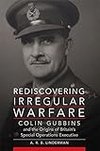
Saved by Ami Pedahzur
Rediscovering Irregular Warfare

Saved by Ami Pedahzur
Gubbins and his colleagues consciously looked to past and contemporary examples for their inspiration.
Paul von Lettow-Vorbeck and the Schutztruppe
The Second Anglo-Boer War
The third element, the “psychological,” was of particular importance to Lawrence considering the Arabs’ relative inferiority. “We were so weak physically that we could not let the metaphysical weapon rust unused.”173 He explains, “We had to arrange [our Arab soldiers’] minds in order of battle, just as carefully and as formally as other officers
... See moreSeveral features make SOE an interesting organization to study within the larger field of special operations. SOE was created within weeks of Britain’s Commandos and the Long Range Desert Group. Moreover, its two predecessor organizations, GS(R) and Section D, trace their origins even earlier. Thus, SOE can legitimately claim to have been one of
... See moreThe Second Anglo-Boer War
In addition, most works that seriously considered guerrilla warfare as a military phenomenon did so from the counterguerrilla’s perspective not from the guerrilla’s own. Thus, Gubbins’s genius lay in synthesizing existing ideas into a concise and usable form.
were those lessons turned on their heads.
Lawrence’s second element, the “biological,” concerned the components of war, “sensitive and illogical” human beings. Because of unknown human factors, commanders are forced to hold a body of men in reserve as a safeguard, thus stretching thin their other human resources. Lawrence worked to magnify his enemy’s ignorance: “We were to contain the
... See more